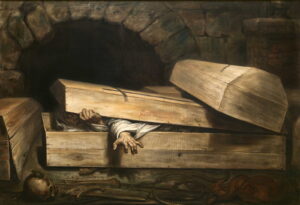Judith and Holofernes: 1 Murder

Warning: this article includes images of paintings showing graphic details of human decapitation.
Life before the twentieth century wasn’t the clean and generally compassionate existence that we have become used to since in the West. Offenders were often mutilated before being executed, and their bodies left on display for birds to feed on; gibbets and other sites of execution were widespread. In many countries in Europe, it wasn’t difficult to witness decapitation and other gruesome forms of death.
The story of Judith and Holofernes may thus seem extreme today, but it and others in similar vein were popular narratives, particularly in their most graphic expression in paintings. This weekend I show a selection of paintings of this Biblical story, in this first article concentrating on the moments of murder, and tomorrow with events before and after.
The Book of Judith, now relegated to the Apocrypha from the Old Testament because of its extensive historical anachronisms, gives the story on which these paintings are based. It tells of how Judith, a beautiful Israelite widow, saved her people when they were threatened by the Assyrians.
She dressed in her finest and perfumed herself lavishly, and went with her maidservant to the Assyrians, promising that she would show them a way to defeat the Israelites. She was taken to Holofernes, Nebuchadnezzar’s general, and stayed with him for three nights, winning his confidence. On the fourth night, he threw a banquet for her, where Holofernes drank so much wine that he fell into a drunken stupor.
With her maid standing guard outside Holofernes’ tent, Judith took his battle sword, and cut his head off:
Approaching to his bed, she took hold of the hair of his head, and said, “Strengthen me, O Lord God of Israel, this day!” And she smote twice upon his neck with all her might, and she took away his head from him. (Judith, 13:7-8.)
Judith then gave Holofernes’ head to her maid, who put it in her bag of meat. The pair left the camp, and returned to the Israelites. Showing the head to them, there was great celebration that she had killed Holofernes, and the Assyrians fled in fear.
In the early seventeenth century, the most popular scenes were those centred on the moments around Judith’s murder of Holofernes.
Michelangelo Merisi da Caravaggio (1571–1610), Judith Beheading Holofernes (c 1598-9), oil on canvas, 145 x 195 cm, Galleria Nazionale d’Arte Antica, Palazzo Barberini, Rome. Wikimedia Commons.
In his Judith Beheading Holofernes from about 1598-9, Caravaggio chooses the moment that Judith has almost completed severing the neck; judging from the gush of bright red blood, this is the moment that the left carotid artery is opened. According to the text narrative, Judith’s maid was still standing outside the tent at this time, but in common with other artists, Caravaggio chose to bring the maid inside to strengthen the effect.
Judith has a facial expression combining anxiety and repulsion, considered to reveal her ambivalence. The expression of her aged maid is even stronger in grim determination. Holofernes’ face is grimaced in shocked agony, just as death is freezing it in place, and his arms show a futile effort to press himself up from his bed. Judith’s right hand grips the sword, perhaps failing to impress us of the force she must be applying to it. Her left hand grips Holofernes by the hair, again in a distant and not forceful manner, and her maid grasps the bag ready to hold the head.
Caravaggio lines the three figures up across the painting, brightly lit against the near-black background. A deep red drape, reminding us of the colour of blood, hangs above the action. He is believed to have used a Roman courtesan, Fillide Melandroni, as the model, and to have recalled what he had earlier seen at the public execution of Beatrice Cenci.
Artemisia Gentileschi painted this story at least three times over a period of less than a decade.
Artemisia Gentileschi (1593–1653), Judith Beheading Holofernes (1611-12), oil on canvas, 158.8 × 125.5 cm, National Museum of Capodimonte, Naples. Wikimedia Commons.
In her earlier Judith Beheading Holofernes from 1611-12 she out-darkens even Caravaggio. Judith, at the right, is at a similar stage in the decapitation, with the sword just about to exit the left neck. Her face shows intense concentration and effort, both arms thrust out straight in front of her. The left grips Holofernes by the hair, the right pushes the blade onwards. Her much younger maid is seen holding Holofernes down, pushing hard with both her arms out straight too. The victim’s right hand seems to be pushing the maid back, but his left arm is folded over his body. His face is contorted in death, an expression similar to that used by Caravaggio.
This was painted at about the same time as Artemisia’s rape and Tassi’s subsequent trial, and it’s generally held that Tassi was the model for Holofernes, she cast herself as Judith, and the female companion who failed to come to her aid during the rape (and failed to give evidence in her support at the trial) was the maid. It would therefore be natural to interpret this painting as part of her very understandable response to her own traumatic events.
Artemisia Gentileschi (1593–1653), Judith Slaying Holofernes (1620-1), oil on canvas, 200 x 162.5 cm, Galleria della Uffizi, Florence. Wikimedia Commons.
Her third version, painted in 1620-21, is similar in most respects, although the view isn’t so tightly cropped on the three figures, so that it shows Holofernes’ legs and a deep red wrap around his lower body. The lower section of the blade is also executed rather better, so that it doesn’t merge with the surface of the bed.
Artemisia Gentileschi (1593–1653), Judith and her Maidservant with the Head of Holofernes (1618-9), oil on canvas, 117 x 93 cm, Palazzo Pitti, Florence. Wikimedia Commons.
A couple of years before that, she had also painted this colder and more detached canvas, showing Judith and her maid making off with Holofernes’ head. Judith here is carrying the sword over her right shoulder, and is looking uncertainly to her left.
Paolo Veronese (Caliari) (1528–88), Judith and Holofernes (c 1580), oil on canvas, 195 x 176 cm, Musei di Strada Nuova, Genova. Wikimedia Commons.
In his Judith and Holofernes from 1580, before Caravaggio’s view of the murder, Veronese shows the moment just after the decapitation, with Judith holding Holofernes’ head, her maid stood by her ready to place it in her black bag, which she holds out. This is entirely consistent with the text narrative, although Veronese adds details such as making Judith’s maid of African origin, and dresses both the women in contemporary rather than historical clothes.
The face of Judith is almost expressionless, that of her maid almost obscured by the angle of view, and that of Holofernes’ head is covered by Judith’s hand, denying any cues from facial expression. Veronese’s composition and angle of view are unusual, placing the viewer above the group, looking down at the scene, the three heads in a tight triangle in the middle of the canvas. The overall effect is matter-of-fact, but clearly holds the tension of the climax of the narrative.
Although Artemisia Gentileschi’s paintings have rivalled Caravaggio’s in fame, this story has also been painted by other contemporary women artists, including the earlier Lavinia Fontana.
Lavinia Fontana (1552–1614), Judith with the Head of Holofernes (1600), oil on canvas, dimensions and location not known. The Athenaeum.
Her Judith with the Head of Holofernes from 1600 has several justifications for its use of chiaroscuro. Here is Judith with the decapitated body of Holofernes, passing the head she has just hacked off to her maidservant. The darkness hides some of the more ghoulish parts of the scene, heightens the sense of drama, and is entirely appropriate for the location and time of day.
Lavinia Fontana (1552–1614), Judith and Holofernes (1600), oil on canvas, 175.9 x 134.1 cm, location not known. Wikimedia Commons.
This version from the same year avoids gore and puts Holofernes’ head discreetly in half-light, while Judith brandishes the sword with pride, and her maid seems to have taken delight in the action.
The last of these paintings of the murder has been attributed to Trophime Bigot, a far more obscure figure who was active slightly later in the seventeenth century.
Trophime Bigot (1579–1650), Judith Cutting Off the Head of Holofernes (c 1640), oil on panel, 125.7 x 196.8 cm, Walters Art Museum, Baltimore, MD. Wikimedia Commons.
Bigot’s Judith Cutting Off the Head of Holofernes (c 1640) shows an even darker scene, lit only by a bundle of candles held by the maid. Composed in a triangle, Judith (left) is seen using both hands to force the sword through Holofernes’ neck, which is probably the most realistic of the versions seen here, although it probably wouldn’t have been possible with a conventional double-edged sword. Most of the blood and gore is obscured in the blackness, apart from a runnel of blood just under the blade.
Judith’s face is surprisingly neutral, almost inquisitive, and her older maid also looks to be studying Holofernes’ neck with interest. Holofernes’ face is similarly contorted as shown earlier by Gentileschi and Caravaggio.
The other obvious problem in this painting is the arms. The maid’s are well clear of the action, her right hand clutching the candles, her left Holofernes’ right wrist. That leaves three arms unaccounted for: Judith’s are both holding the sword, her left arm crossing Holofernes’ right shoulder, making it appear dislocated. His left hand, clenched into a fist, appears from nowhere at Judith’s left shoulder, and seems disembodied.
References
Contini R & Solinas F (2011) Artemisia Gentileschi, The Story of a Passion, 24 ORE Cultura, Milan. ISBN 978 88 7179 668 0.
Locker JM (2015) Artemisia Gentileschi. The Language of Painting, Yale UP. ISBN 978 0 300 18511 9.
Salomon XF (2014) Veronese, National Gallery Co and Yale UP. ISBN 978 1 85709 553 1.
Straussman-Pflanzer E (2013) Violence & Virtue. Artemisia Gentileschi’s ‘Judith Slaying Holofernes’, Yale UP. ISBN 978 0 300 18679 6.




